Six insightful data sets underscore the rapid rise of interest in Bitcoin inscriptions, demonstrating their undeniable impact.
Inscribing bits of data onto the Bitcoin blockchain through Ordinals has captured the attention of cryptocurrency enthusiasts inside and beyond Bitcoin since the start of 2023.
Whether or not Bitcoin “should” be used for this NFT-like activity is a hotly-contested issue and the data coming from the effects of this mini Bitcoin collectives craze is intriguing. Inscriptions could be a short-lived fad, but several early data sets from the first weeks of inscription activity show tremendous interest in this new use case for the Bitcoin network. Diving in, this article provides an overview of six sets of data from the inscription mania.
Overview Of Bitcoin Inscriptions Data
The amounts and weights of pending transactions in Bitcoin mempools around the world are a clear signal of how popular inscription transactions have been to Bitcoin users amid the ongoing mini-craze over Bitcoin NFTs. Throughout most of the current bear market cycle, pending transaction levels in Bitcoin mempools have stayed fairly low, especially when compared to the height of both the 2017 and 2021 bull markets. In fact, a Twitter bot called Mempool Alert tweets every time its mempool empties, and the tweets were posted on a consistent basis for months throughout 2022.
The mempool pending transactions visual below shows the total weight of unconfirmed transactions throughout most of February 2023. The surge in pending transactions directly correlates to the inscriptions craze, which has somewhat subsided toward the end of February.
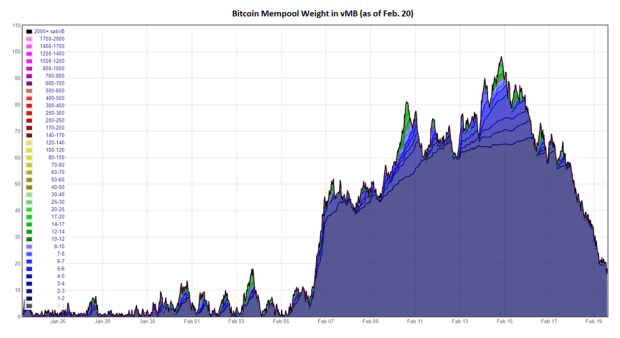
Inscription transactions are notoriously large, and the block sizes that have come from the inscription craze prove it. For years, the sizes of Bitcoin blocks hovered just below 1.5 megabytes (MB) as the line chart below illustrates. But the vertical increase in block sizes on the far right side of the chart is due entirely to Bitcoin inscriptions.
With these Bitcoin NFTs becoming popular, blocks started being produced between 2 MB and 2.5 MB on average. Several blocks flirted with the 4 MB limit, including the “giant” Taproot Wizard block mined by Luxor in collaboration with Udi Wertheimer and others.
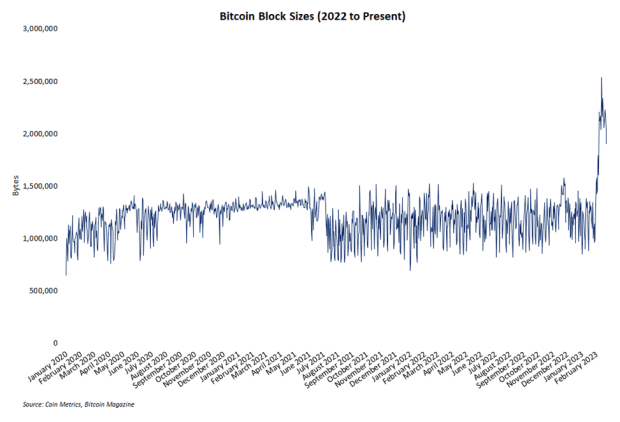
Switching to a bit of “off-chain” data, the interest in Bitcoin inscriptions is also apparent from Google Search queries. The line chart below is taken from the Google Trends page for search interest in “Bitcoin Ordinals,” and the near-vertical increase in interest over time is impossible to miss. It should be noted that these search trends data sets are scored on a relative basis to search interest in weeks and years past. But of particular noteworthiness is that Google Trends has indexed this phrase at all. Not every term or phrase is indexed by Google Trends, only those with a material amount of minimum search volume over time. That trending data for “Bitcoin Ordinals” made the database at all is remarkable.
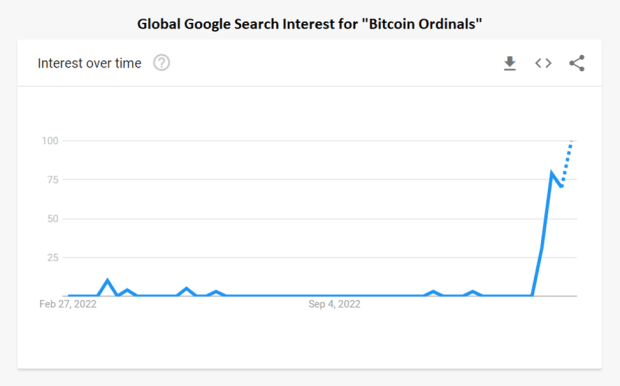
Critics of NFTs — and especially of inscriptions on Bitcoin — will occasionally slight the entire type of network use as a form of “privilege” by elites in developed countries goofing around with a serious monetary network. But global trends for Ordinals searches don’t show the U.S. as even a top-five country. Singapore, Czechia, Portugal and Singapore top the list, according to Google’s data.
Sorting by transaction forms included in blocks also illustrates the intensity of the inscriptions craze that kicked off 2023 for Bitcoin. According to data shared to Twitter from a Bitcoin node run by Pierre Rochard, the research director at Riot Blockchain, inscription transactions accounted for nearly 60% of block space near the height of the Bitcoin community’s first foray into Ordinals. As the data visualization below illustrates, that number steadily grew from 20% to 60% within a week.
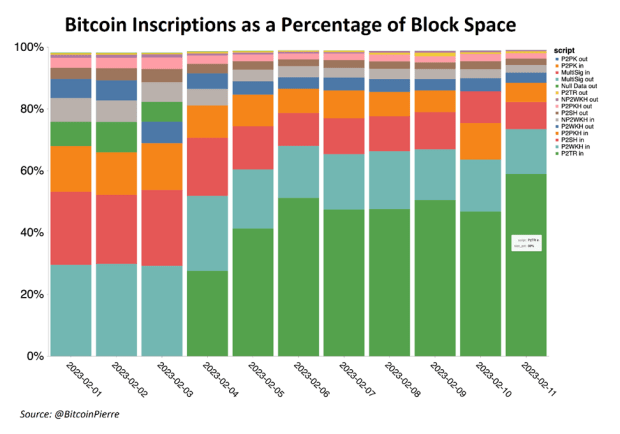
Community data from groups of inscriptions enthusiasts also present some additional context for this social and technical movement inside of Bitcoin. The bar chart below represents data compiled by OrdinalHub with a list of original inscription Discord groups and their member counts as of early February.
By a large margin, Satoshibles and Taproot Wizards were the largest communities at that point in time. But the sheer number of Discord groups that almost instantaneously were created signals the passion that Bitcoin artists have had for this new use for the network.
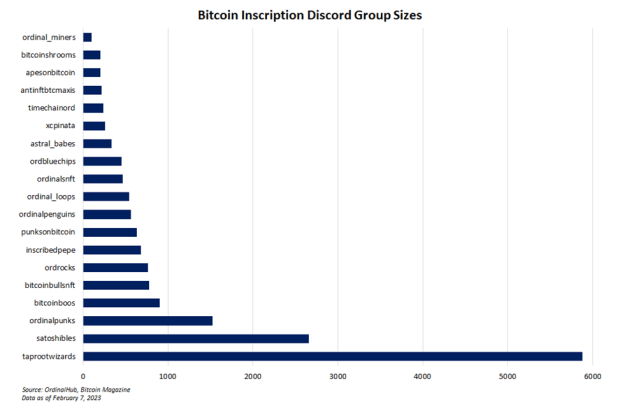
At present, many of the Discords are certainly larger than the data in the above chart represent. But by now, some of the data is sure to have been corrupted by bots and various other spoofs (intentional or not) of community data, which makes this data snapshot taken near the communities origins unique.
One final piece of data that deserves inclusion in any analysis of Bitcoin inscriptions is around the money — how much miners are making from “the inscribeoooors” who etch their bits of data into the Bitcoin network. Miners are being paid handsomely for building blocks with inscription transactions.
In the line-bar combination chart shown below, daily amounts spent on inscription transaction fees and the total aggregate amount paid to miners from inscription transactions are visualized. In a few short weeks, well over $1 million has been paid out to miners from inscribers. And this data only captures the on-chain payments — out-of-band payments are not included here, which would make the number somewhat larger.
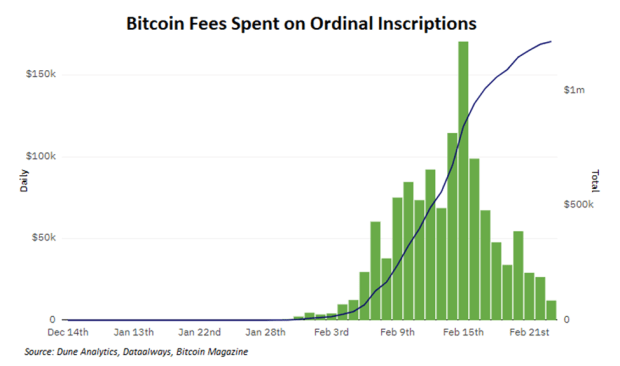
Even though much of the early data sets show that the intensity of early inscription activity has tapered off relative to its highs toward the end of February, how long this trend will last is unknown. It could be a fad that dies out before the current bear market ends, and inscription critics can then dance on the grave of Bitcoin NFTs. Or it could become a longstanding fixture of demand for block space and regular fee revenue for miners.
The future is uncertain, but the possible effects of inscriptions are impossible to ignore.
This is a guest post by Zack Voell. Opinions expressed are entirely their own and do not necessarily reflect those of BTC Inc or Bitcoin Magazine.
source https://bitcoinmagazine.com/culture/quantifying-bitcoin-inscriptions-ordinals

No comments:
Post a Comment